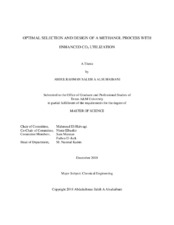| dc.description.abstract | The recent discoveries of significant reserves of shale gas have spurred various monetization pathways including the production of methanol. There are several routes to convert shale/natural gas to methanol. The decisions for technology selection and process design were typically based on techno-economic criterial. Because of the growing interest in reducing the greenhouse gas emissions of gas processing, carbon footprint is emerging as a primary criterion in the selection and design of the process. The purpose of this work is to carry out process synthesis, selection, and design of a shale-gas to methanol process with multiple objectives including profitability and carbon footprint. Several reforming pathways along with the associated downstream processing are considered. In addition to the screening of individual types of reforming, the study also considers combined reforming of methane which incorporates three types of reforming, namely steam reforming, partial oxidation, and dry reforming. It is desired to consider existing technologies and to also modify the design of an existing methanol technology to include combined reforming. Utilization of COv2 is addressed while maintaining the suitable syngas ratio for methanol synthesis, and minimizing COv2 emissions, waste water generation, and energy requirements of the overall process. A methanol from natural gas production plant with a capacity of processing 280 MMSCFD is considered as the base case scenario. The plant employs conventional reforming (e.g. steam reforming, partial oxidation, or ATR) to generate syngas for methanol synthesis. Aspen HYSYS is used to simulate the process scenarios and SWROIM is used to aid determining the ultimate reforming configuration based on economic and sustainability indicators. Heat and power integration are performed to improve the sustainability and profitability of the process, through identifying water and heat sinks in the overall design. A techno-economic
analysis of the proposed designs are conducted, including the fixed capital cost, carbon taxes, and utility requirements. Sensitivity analysis of each proposed design is carried out to assess the impact of natural gas and methanol prices on the profitability. Additionally, sensitivity analysis is performed to evaluate the effects of imposing carbon tax and carbon credit regulations.
Keywords: syngas, carbon footprint, integration, design, sustainability. | en |


